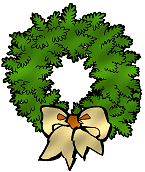
WHERE DID CHRISTMAS TREES COME FROM?
Christmas trees
seem to have their origins in the
ancient celebrations of Saturnalia.
The Romans decorated
their temples with greenery and candles.
Roman soldiers conquering the British
Isles found
Druids who worshipped mistletoe
and Saxons who
used holly and
ivy in religious ceremonies.
All those things found their way
into
Christmas customs.
Interestingly,
however, the first person to have lighted
a Christmas tree may have been
Martin Luther,
father of the Reformation.
He introduced the practice of putting
candles on trees to celebrate
Christmas, citing Isaiah 60:13
as biblical authority for the
practice: "The
glory of Lebanon will come to you,
the juniper, the box tree, and
the
cypress together,
to beautify the place of My sanctuary;
and I shall make the place of
My feet glorious."
This excerpt was taken from
The Miracle of Christmas by John
F. MacArthur, Jr.
Copyright (c)
Zondervan Publishing House, 1995.

THE TRADITION of the
CHRISTMAS TREE
The modern Christmas tree seems to have
originated in Germany during the Middle
Ages. A main prop in a medieval play about
Adam and Eve was a fir tree hung with
apples. Called the "Paradise tree," it
represented the Garden of Eden. German
families set up a Paradise tree in their
homes on December 24, the feast day of
Adam and Eve. On it they hung wafers,
symbolizing the bread distributed at the
celebration of the holy eucharist, or
communion, in churches. Because the
Christmas holiday followed immediately,
candles representing Christ as the light of
the world were often added to the tree.
Eventually cookies and other sweets were
hung instead of wafers.

Christmas trees have been sold commercially
in the United states since about 1850. Until
fairly recently, all Christmas trees came from
the forest.
Thirty-four to thirty-six million Christmas
trees are produced each year and 95 percent
are shipped or sold directly from Christmas
tree farms.
California, Oregon, Michigan, Washington,
Wisconsin, Pennsylvania and North Carolina
are the top Christmas tree producing states.
The best selling trees are Scotch pine,
Douglas fir, Noble fir, Fraser fir, Virginia pine,
Balsam fir and white pine.
Over one million acres of land have been
planted in Christmas trees. The industry
employs over 100,000 people. Many
Christmas tree growers grow trees on a
part-time basis to supplement farm and
non-farm income.
More than 2,000 trees are usually planted per
acre. On an average 1,000-1,500 of these
trees will survive. In the North, maybe, 750
trees will remain. Almost all trees require
shearing to attain the Christmas tree shape.
At six to seven feet, trees are ready for
harvest. It takes six to ten years of fighting
heavy rain, wind, hail and drought to get a
mature tree.
Selling directly to the consumer has become a
major market for many Christmas tree farms.
Some tree farms offer the consumer the
chance to select his own tree while it is still
growing in the tree farm.
In the United States, there are over 5,000
Christmas tree farms and 15,000 Christmas
tree growers.

THE FIRST CHRISTMAS TREE
The decorated Christmas
tree can be traced back to the ancient
Romans who during
their winter festival
decorated trees with small pieces of metal.
An evergreen, the Paradise
tree,
was decorated with apples as a
symbol of the feast of
Adam and Eve held
on December 24th during the middle ages.
In the 16th century
Martin Luther was credited as being
the first to decorate an indoo
tree.
After a walk through a forest of
evergreens with
shining stars overhead,
Luther tried to describe the experience
to his family
and showed them by bringing a tree
into
their home and decorating
it with candles.
The custom of the Christmas
tree was introduced in the
United States during the War of
Independence by Hessian troops.
An early account tells of a Christmas
tree set up
by American soldiers
at Fort Dearborn, Illinois,
the site of Chicago, in 1804.
Most other early accounts in the
United States were among the
German settlers in eastern
Pennsylvania.
By 1850, the Christmas
tree had become fashionable in the eastern states.
Until this time, it had been considered
a quaint foreign custom.
Franklin Pierce was
the first president to introduce the
Christmas tree to the White
House in 1856 for
a group of Washington Sunday School children.
The first national Christmas Tree
was lighted in the year 1923 on the
White House lawn by President Calvin
Coolidge.